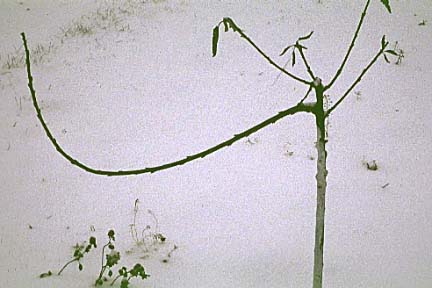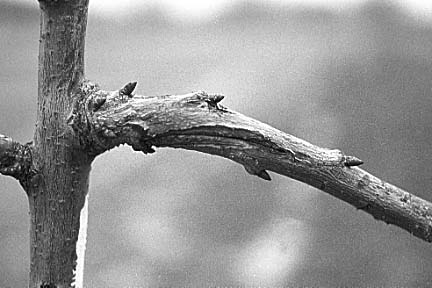
Dear Virtual Orchard readers,
"CHERRY FLOPPY DISORDER" - This disorder was seen for the first and only time to date in sweet cherry trees ranging in age from newly planted to bearing (3-4 yrs.) at the New York State Agricultural Experiment Station. After twigs got to about 15 to 20 inches in length they started to crack at the 1st vegetative bud, or in the internode between the 1st and 2nd bud. They always cracked on the top of the twig, and sometimes broke completely off and in others they cracked just enough to allow the twigs to flop sideways and hang in a weepy appearing state. In still other cases some of the twigs were unbroken but have a stress line near the 1st or 2nd bud. In some cases they came loose in the socket (attachment point to the central leader). In cases where the

"flopped" twig was not too severly broken they made lots of callus to repair the damage. The most peculiar part of this whole enigma is that tree to tree differences within a row are very evident, indicating it is genetic in nature -- since the main purpose of the trials is variety evaluation.
Some varieties have none, but some are quite severe, and first year trees have most of the top branches affected and 2-4 year olds have a few of the top new twigs on the leader and on secondary laterals also affected. I suppose that we might have just passed off these symptoms as wind damage in most years, but since they were much more severe in one site than another and had such varietal differneces in symptom levels, we became suspicious that a physiological effect was involved, possibly due to a pesticide secondary effect. I'm still very much in the dark as to what is the cause. In my pomological opinion it is not just wind, although it is worst on the west side of trees and in more windy sites. A 2nd leaf orchard and a 1st leaf orchard at other Geneva-region farms had liitle or no signs of this disorder.

These trees have also been examined by plant pathologists and entomologists here at the Station, with no definitive answers. Scolytid beetles were observed in a very small number tunneling into the bark near breaks where branches had twisted out of their"sockets" at a crotch. Very few were found, however, and tunneling damage was not extensive, so these can probably be ruled out. Spring weather/herbicide interaction is another possible culprit. Spring 1996 was quite cool and wet. Herbicides used prior to symptom development were simazine(5/6), Fusilade+COC (5/23), Poast +COC (6/12) and Roundup (6/18). Symptoms became apparent sometime in early July. First year trees that were planted later in the spring than the affected trees had none of the problem nor did tart cherries, plums, apricots or peaches that were planted at the Station.
Thanks in advance for any answers/leads you all may provide to this perplexing, devastating problem.
If you have seen this or wish to comment or just have a suggestion, please contact:
Robert L. Andersen, Professor of Horticulture
NYSAES, Geneva, NY
315-787-2235